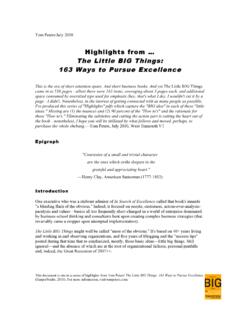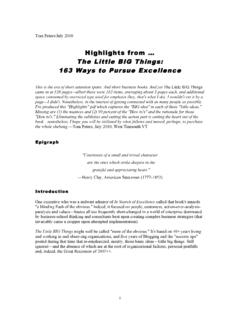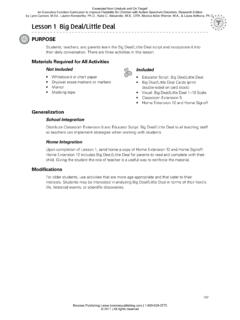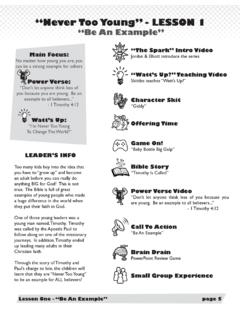Transcription of From Little Things, Big Things Grow - One World for Children
1 407-411 Thompson Road (Corner Kelly Crt), North Geelong 3215 Telephone (03) 5272 2714, Fax (03) 5272 3039 the season to be growing! Spring has arrived. Plants are sprouting, fl owers are blooming and vegetables are growing. What a perfect opportunity for Children to learn about nature and growing foods. There is nothing quite like the delight of growing your own vegetables, fl owers or grass. Generally growing vegetables is easy (compared to other plants), depending on the type chosen. Nor do you need masses of space to grow vegetables or a specifi ed vegetable plot, since there are more and more possibilities for growing vegetables in containers, such as potato planters, plant pots, hanging baskets or window boxes.
2 Vegetables are actually some of the easiest plants to grow , especially from seed. To encourage Children s enthusiasm, let them choose what types of vegetables they want to grow and you will both be delighted with the results. Flowers and grass can be planted in small individual pots or paper cups. The opportunities are endless. Given half a chance (and a minimum of encouragement), most Children will become totally enthralled by the magic of gardening, especially if they have their own plot or, at the very least, a pot to look will be most excited about growing something they can eat. Many Children have Little idea that peas grow in pods on a plant or that the beetroot on the hamburger bun didn t start its life in a tin.
3 Imagine their excitement when they can sow seeds into the soil and follow the plant right through until it s ready for picking. An edible garden is a garden that contains fl owers, herbs, seeds, berries and plants that you can eat. Children like large, brightly coloured fl owers and vegetables that grow quickly. Plants like sunfl owers, corn and pumpkins are suitable. You should also consider using varieties of plants that have sensory and textural qualities as well. Sensory plants are plants that have special smell, taste, touch and sight for Children is valuable, they will learn about nature, the environment and responsibility but can also learn many new skills, continued on page 2 From Little Things , Big Things GrowSPRING / 2010 Page 2 From Little Things , Big Things grow (cont.)
4 Have fun, play and develop self-confi dence by spending time in the garden tending to plants and growing, preparing and using their own food. Most Children enjoy being outdoors and love digging in the soil, getting dirty, creating Things and watching plants grow . Planting and growing gardens is like digging and fi nding treasure. Toddlers, preschool, primary school aged and older Children will all have different expectations and learning experiences from exposure to gardening and growing experiences. Younger Children will require careful supervision during activities.
5 Older Children are physically capable of handling a variety of activities including lifting, carrying, mulching and pruning. Infants can watch Things grow and even smell the different aromas. Toddlers can water plants, preschoolers can plant, take care of seeds and participate in cooking activities and school age Children can take full responsibility for planting, growing, harvesting, preparing and cooking with Children will be naturally interested in their surrounding environment; however there are some ways you can encourage interest and curiosity.
6 Show enthusiasm yourself, read books, take notice of Things that might be growing in gardens outdoors, bring fresh fl owers into the room (providing no allergies), have a couple of small plants indoors at Children s level then regularly fl ower. Ask Children open ended questions about the outdoor environment when playing outside or even talk about plants and foods at mealtimes. Introduce new objects or props such as a scarecrow into the garden, get Children to make them. Use a compost bin for scraps, use worms farms in tanks for Children to watch or even involve Children in preparation of amazing how starting from one small thing, how big Things grow !
7 The educational benefi ts and development of new skills and knowledge includes: Responsibility - from caring for and tending plants. Understanding - as they learn about cause and effect (for example, plants won t thrive without water, weeds compete with plants etc). Self confi dence - from achieving their goals and enjoying the food they have grown. Love of nature - a chance to learn about the outdoor environment in a safe and pleasant place. Reasoning and discovery - as they learn about science, botany, nutrition and simple construction. Physical activity - that is fun and productive.
8 Cooperation - including shared play activity and teamwork. Creativity - fi nding new and exciting ways to grow food. Curiosity- about nature and the World around them. Nutrition - learning about sources of fresh food. Healthy foods. Cooking - Preparing food, using utensils and the science of cooking. Safety and hygiene - In preparation of food, use of tools and utensils, washing foods and hands, eating safe foods from nature. Creates a sense of belonging working together with others and maintaining connections to their home life s and the environment that surrounds them. Refl ects and shapes Identity Use of cultural foods and seeds.
9 Creates a homelike environment. Teaches Children different concepts and capabilities of are numerous experiences where Children can be involved in gardening. Preparing the soil with organic fertiliser. Planting vegetables, fruits and fl owers in the correct season. Watering the garden. Weeding. Gathering seeds and dried fl owers. Deadheading fl owers. Replanting and re-potting. Composting, recycling and mulching. Using the worms from the worm farm. Picking vegetables and fruits when they are ready to eat. Preparing food. Healthy cooking, making salads and preparing school idea s you may not have thought of: Encourage older Children to track growth of plants or vegetables by either measuring or drawing pictures.
10 grow grass in large pots and use as a prop for small wooden dolls and furniture. grow grass in garden beds or wooden boxes to use as seats. Make grass heads where Children can make their own hair styles with grass. Crazy caterpillars. Plant surprise vegetables like purple caulifl ower, red lettuce, a tomato that masquerades as a pepper. Encourage Children to pick and try food fresh from the of a GardenWhen planning the Children s vegetable garden, let them not only choose the plants, but also the location and layout. Just be sure that the garden is located in a sunny area that is easily accessible to water.









